Approaches to Preceramic Polymer Fiber Fabrication and On-Demand Applications
Abstract
:1. Introduction
2. Discussion
2.1. Production of Fibers
2.1.1. Electrospinning
2.1.2. Blow Spinning
3. Influence of Polymer Structure
4. Polymer Backbone Structure
5. Interaction with Fillers and Fibers
6. Surface Modification
7. Applications of Preceramic Fibers
7.1. Aerospace
7.2. High Temperature
7.3. Biomedical
7.4. Sensors
7.5. Electronic Devices
8. Conclusions
Author Contributions
Funding
Data Availability Statement
Conflicts of Interest
References
- Wang, J.-C.; Dommati, H.; Hsieh, S.-J. Review of additive manufacturing methods for high-performance ceramic materials. Int. J. Adv. Manuf. Technol. 2019, 103, 2627–2647. [Google Scholar] [CrossRef]
- Nishihora, R.K.; Rachadel, P.L.; Quadri, M.G.N.; Hotza, D. Manufacturing porous ceramic materials by tape casting—A review. J. Eur. Ceram. Soc. 2018, 38, 988–1001. [Google Scholar] [CrossRef]
- Bajraktarova-Valjakova, E.; Korunoska-Stevkovska, V.; Kapusevska, B.; Gigovski, N.; Bajraktarova-Misevska, C.; Grozdanov, A. Contemporary Dental Ceramic Materials, A Review: Chemical Composition, Physical and Mechanical Properties, Indications for Use. Open Access Maced. J. Med Sci. 2018, 6, 1742–1755. [Google Scholar] [CrossRef] [PubMed] [Green Version]
- Rakshit, R.; Das, A.K. A review on cutting of industrial ceramic materials. Precis. Eng. 2019, 59, 90–109. [Google Scholar] [CrossRef]
- Lakhdar, Y.; Tuck, C.; Binner, J.; Terry, A.; Goodridge, R. Additive manufacturing of advanced ceramic materials. Prog. Mater. Sci. 2020, 116, 100736. [Google Scholar] [CrossRef]
- Medvedev, D.A. Current drawbacks of proton-conducting ceramic materials: How to overcome them for real electrochemical purposes. Curr. Opin. Green Sustain. Chem. 2021, 32, 100549. [Google Scholar] [CrossRef]
- Cramer, C.L.; Ionescu, E.; Graczyk-Zajac, M.; Nelson, A.T.; Katoh, Y.; Haslam, J.J.; Wondraczek, L.; Aguirre, T.G.; LeBlanc, S.; Wang, H.; et al. Additive manufacturing of ceramic materials for energy applications: Road map and opportunities. J. Eur. Ceram. Soc. 2022, 42, 3049–3088. [Google Scholar] [CrossRef]
- Clauß, B. Fibers for Ceramic Matrix Composites; Wiley-VCH: Weinheim, Germany, 2008. [Google Scholar]
- Liu, Y.; Jiang, X.; Shi, J.; Luo, Y.; Tang, Y.; Wu, Q.; Luo, Z. Research on the interface properties and strengthening–toughening mechanism of nanocarbon-toughened ceramic matrix composites. Nanotechnol. Rev. 2020, 9, 190–208. [Google Scholar] [CrossRef] [Green Version]
- Du, J.; Zhang, H.; Geng, Y.; Ming, W.; He, W.; Ma, J.; Cao, Y.; Li, X.; Liu, K. A review on machining of carbon fiber reinforced ceramic matrix composites. Ceram. Int. 2019, 45, 18155–18166. [Google Scholar] [CrossRef]
- Diaz, O.G.; Luna, G.G.; Liao, Z.; Axinte, D. The new challenges of machining Ceramic Matrix Composites (CMCs): Review of surface integrity. Int. J. Mach. Tools Manuf. 2019, 139, 24–36. [Google Scholar] [CrossRef]
- Arai, Y.; Inoue, R.; Goto, K.; Kogo, Y. Carbon fiber reinforced ultra-high temperature ceramic matrix composites: A review. Ceram. Int. 2019, 45, 14481–14489. [Google Scholar] [CrossRef]
- Binner, J.; Porter, M.; Baker, B.; Zou, J.; Venkatachalam, V.; Diaz, V.R.; D’Angio, A.; Ramanujam, P.; Zhang, T.; Murthy, T.S.R.C. Selection, processing, properties and applications of ultra-high temperature ceramic matrix composites, UHTCMCs—A review. Int. Mater. Rev. 2019, 65, 389–444. [Google Scholar] [CrossRef]
- An, Q.; Chen, J.; Ming, W.; Chen, M. Machining of SiC ceramic matrix composites: A review. Chin. J. Aeronaut. 2020, 34, 540–567. [Google Scholar] [CrossRef]
- Devasia, R.; Painuly, A.; Devapal, D.; Sreejith, K. Continuous fiber reinforced ceramic matrix composites. In Fiber Reinforced Composites; Woodhead Publishing: Sawston, UK, 2021; pp. 669–751. [Google Scholar] [CrossRef]
- Ferreira, R.K.M.; Ramlow, H.; Marangoni, C.; Machado, R.A.F. A review on the manufacturing techniques of porous hydrophobic ceramic membranes applied to direct contact membrane distillation. Adv. Appl. Ceram. 2021, 120, 336–357. [Google Scholar] [CrossRef]
- Henning, L.M.; Abdullayev, A.; Vakifahmetoglu, C.; Simon, U.; Bensalah, H.; Gurlo, A.; Bekheet, M.F. Review on Polymeric, Inorganic, and Composite Materials for Air Filters: From Processing to Properties. Adv. Energy Sustain. Res. 2021, 2, 2100005. [Google Scholar] [CrossRef]
- Stabler, C.; Ionescu, E.; Graczyk-Zajac, M.; Gonzalo-Juan, I.; Riedel, R. Silicon oxycarbide glasses and glass-ceramics: “All-Rounder” materials for advanced structural and functional applications. J. Am. Ceram. Soc. 2018, 101, 4817–4856. [Google Scholar] [CrossRef]
- Chawla, K.K. Composite Materials: Science and Engineering; Springer: New York, NY, USA, 2012; Available online: https://books.google.com/books?hl=en&lr=&id=rbuNxwzM27cC&oi=fnd&pg=PR7&dq=These+fibers+are+made+by+soaking+with+preceramic+precursor+materials+or+depositing+precursor+materials+on+the+surface.+The+inorganic+fiber+is+then+formed+by+pyrolysis+of+the+organic+template+fiber.+On+the+other+hand,+the+direct+process+involves+the+direct+&ots=UphMpqJeh-&sig=SA43ZjxxkfMVB2H8__8vOfmj0O8#v=onepage&q&f=false (accessed on 8 May 2022).
- Fang, W.; Yang, S.; Wang, X.L.; Yuan, T.Q.; Sun, R.C. Manufacture and application of lignin-based carbon fibers (LCFs) and lignin-based carbon nanofibers (LCNFs). Green Chem. 2017, 19, 1794–1827. [Google Scholar] [CrossRef]
- Whitaker, T.W.; Cutler, H.C. Cucurbits from Preceramic Levels at Guilá Naquitz. In Guilá Naquitz; Routledge: London, UK, 2021; pp. 275–279. [Google Scholar] [CrossRef]
- Chen, H.; Wang, X.; Xue, F.; Huang, Y.; Zhou, K.; Zhang, D. 3D printing of SiC ceramic: Direct ink writing with a solution of preceramic polymers. J. Eur. Ceram. Soc. 2018, 38, 5294–5300. [Google Scholar] [CrossRef]
- Cagnato, C. Gathering and Sowing Across the Central Maya Lowlands: A Review of Plant Use by Preceramic Peoples and The Early to Middle Preclassic Maya. Anc. Mesoam. 2021, 32, 486–501. [Google Scholar] [CrossRef]
- Hotza, D.; Nishihora, R.K.; Machado, R.; Geffroy, P.; Chartier, T.; Bernard, S. Tape casting of preceramic polymers toward advanced ceramics: A review. Int. J. Ceram. Eng. Sci. 2019, 1, 21–41. [Google Scholar] [CrossRef]
- Smith, C.E. Preceramic Plant Remains from Guilá Naquitz. In Guilá Naquitz; Routledge: London, UK, 2021; pp. 265–274. [Google Scholar] [CrossRef]
- Bernardo, E.; Fiocco, L.; Parcianello, G.; Storti, E.; Colombo, P. Advanced Ceramics from Preceramic Polymers Modified at the Nano-Scale: A Review. Materials 2014, 7, 1927–1956. [Google Scholar] [CrossRef] [PubMed]
- Sujith, R.; Jothi, S.; Zimmermann, A.; Aldinger, F.; Kumar, R. Mechanical behaviour of polymer derived ceramics—A review. Int. Mater. Rev. 2020, 66, 426–449. [Google Scholar] [CrossRef]
- Scholz, H.; Vetter, J.; Herborn, R.; Ruedinger, A. Oxide ceramic fibers via dry spinning process—From lab to fab. Int. J. Appl. Ceram. Technol. 2020, 17, 1636–1645. [Google Scholar] [CrossRef] [Green Version]
- Viard, A.; Fonblanc, D.; Lopez-Ferber, D.; Schmidt, M.; Lale, A.; Durif, C.; Balestrat, M.; Rossignol, F.; Weinmann, M.; Riedel, R.; et al. Polymer Derived Si-B-C-N Ceramics: 30 Years of Research. Adv. Eng. Mater. 2018, 20, 1800360. [Google Scholar] [CrossRef]
- Zhao, Z.; Li, K.; Li, W.; Liu, Q.; Kou, G.; Zhang, Y. Preparation, ablation behavior and mechanism of C/C-ZrC-SiC and C/C-SiC composites. Ceram. Int. 2018, 44, 7481–7490. [Google Scholar] [CrossRef]
- Du, B.; Hong, C.; Zhang, X.; Wang, J.; Qu, Q. Preparation and mechanical behaviors of SiOC-modified carbon-bonded carbon fiber composite with in-situ growth of three-dimensional SiC nanowires. J. Eur. Ceram. Soc. 2018, 38, 2272–2278. [Google Scholar] [CrossRef]
- Zhang, L.; Pei, L.; Li, H.; Li, S.; Liu, S.; Guo, Y. Preparation and characterization of Na and F co-doped hydroxyapatite coating reinforced by carbon nanotubes and SiC nanoparticles. Mater. Lett. 2018, 218, 161–164. [Google Scholar] [CrossRef]
- Wen, Q.; Yu, Z.; Riedel, R. The fate and role of in situ formed carbon in polymer-derived ceramics. Prog. Mater. Sci. 2020, 109, 100623. [Google Scholar] [CrossRef]
- Chen, A.-N.; Wu, J.-M.; Han, L.-X.; Cheng, L.-J.; Liu, R.-Z.; Zhang, X.-Y.; Shi, Y.-S.; Li, C.-H. Preparation of Si3N4 foams by DCC method via dispersant reaction combined with protein-gelling. J. Alloys Compd. 2018, 745, 262–270. [Google Scholar] [CrossRef]
- Han, L.; Wang, J.; Li, F.; Wang, H.; Deng, X.; Zhang, H.; Zhang, S. Low-temperature preparation of Si3N4 whiskers bonded/reinforced SiC porous ceramics via foam-gelcasting combined with catalytic nitridation. J. Eur. Ceram. Soc. 2018, 38, 1210–1218. [Google Scholar] [CrossRef]
- Nguyen, V.L.; Zera, E.; Perolo, A.; Campostrini, R.; Li, W.; Sorarù, G.D. Synthesis and characterization of polymer-derived SiCN aerogel. J. Eur. Ceram. Soc. 2015, 35, 3295–3302. [Google Scholar] [CrossRef]
- Bermúdez, M.D.; Jiménez, A.E.; Sanes, J.; Carrión, F.J. Ionic liquids as advanced lubricant fluids. Molecules 2009, 14, 2888–2908. [Google Scholar] [CrossRef] [PubMed]
- Greil, P. Polymer Derived Engineering Ceramics. Adv. Eng. Mater. 2000, 2, 339–348. [Google Scholar] [CrossRef]
- Bansal, N.P.; Boccaccini, A.R. (Eds.) Ceramics and Composites Processing Methods; Wiley: Hoboken, NJ, USA, 2012; Available online: https://www.wiley.com/en-us/Ceramics+and+Composites+Processing+Methods-p-9780470553442 (accessed on 6 June 2021).
- Barroso, G.; Li, Q.; Bordia, R.K.; Motz, G. Polymeric and ceramic silicon-based coatings—A review. J. Mater. Chem. A,. 2019, 7, 1936–1963. [Google Scholar] [CrossRef]
- Janakiraman, N.; Aldinger, F. Fabrication and characterization of fully dense Si–C–N ceramics from a poly (ureamethylvinyl) silazane precursor. J. Eur. Ceram. Soc. 2009, 29, 163–173. [Google Scholar] [CrossRef]
- Yu, Z.; Yang, L.; Zhan, J.; Zhou, C.; Min, H.; Zheng, Q.; Xia, H. Preparation, cross-linking and ceramization of AHPCS/Cp2ZrCl2 hybrid precursors for SiC/ZrC/C composites. J. Eur. Ceram. Soc. 2012, 32, 1291–1298. [Google Scholar] [CrossRef]
- Bechthold, M.; Weaver, J.C. Materials science and architecture. Nat. Rev. Mater. 2017, 2, 17082. [Google Scholar] [CrossRef]
- Sigmund, W.; Yuh, J.; Park, H.; Maneeratana, V.; Pyrgiotakis, G.; Daga, A.; Taylor, J.; Nino, J.C. Processing and structure relationships in electrospinning of ceramic fiber systems. J. Am. Ceram. Soc. 2006, 89, 395–407. [Google Scholar] [CrossRef]
- Zaarour, B.; Zhu, L.; Huang, C.; Jin, X.; Alghafari, H.; Fang, J.; Lin, T. A review on piezoelectric fibers and nanowires for energy harvesting. J. Ind. Text. 2019, 51, 297–340. [Google Scholar] [CrossRef]
- Baldus, P.; Jansen, M.; Sporn, D. Ceramic Fibers for Matrix Composites in High-Temperature Engine Applications. Science 1999, 285, 699–703. [Google Scholar] [CrossRef]
- Jia, C.; Xu, Z.; Luo, D.; Xiang, H.; Zhu, M. Flexible ceramic fibers: Recent development in preparation and application. Adv. Fiber Mater. 2022, 1–31. [Google Scholar] [CrossRef]
- Gottardo, L.; Bernard, S.; Gervais, C.; Inzenhofer, K.; Motz, G.; Weinmann, M.; Balan, C.; Miele, P. Chemistry, structure and processability of boron-modified polysilazanes as tailored precursors of ceramic fibers. J. Mater. Chem. 2012, 22, 7739–7750. [Google Scholar] [CrossRef]
- Swalen, J.D.; Allara, D.L.; Andrade, J.D.; Chandross, E.A.; Garoff, S.; Israelachvili, J.; McCarthy, T.J.; Murray, R.; Pease, R. Molecular monolayers and films. A panel report for the Materials Sciences Division of the Department of Energy. Langmuir 1987, 3, 932–950. [Google Scholar] [CrossRef]
- Hufenus, R.; Yan, Y.; Dauner, M.; Kikutani, T. Melt-Spun Fibers for Textile Applications. Materials 2020, 13, 4298. [Google Scholar] [CrossRef] [PubMed]
- Warlin, N.; Nilsson, E.; Guo, Z.; Mankar, S.V.; Valsange, N.G.; Rehnberg, N.; Lundmark, S.; Jannasch, P.; Zhang, B. Synthesis and melt-spinning of partly bio-based thermoplastic poly(cycloacetal-urethane)s toward sustainable textiles. Polym. Chem. 2021, 12, 4942–4953. [Google Scholar] [CrossRef]
- Regnier, J.; Cayla, A.; Campagne, C.; Devaux, É. Melt Spinning of Flexible and Conductive Immiscible Thermoplastic/Elastomer Monofilament for Water Detection. Nanomaterials 2021, 12, 92. [Google Scholar] [CrossRef]
- Tavanaie, M.A. Engineered biodegradable melt-spun fibers. In Engineered Polymeric Fibrous Materials; Woodhead Publishing: Sawston, UK, 2021; pp. 191–232. [Google Scholar] [CrossRef]
- Ren, Z.; Gervais, C.; Singh, G. Fabrication and characterization of silicon oxycarbide fibre-mats via electrospinning for high temperature applications. RSC Adv. 2020, 10, 38446–38455. [Google Scholar] [CrossRef]
- Lusha, Z.; Zicheng, T.; Tusiime, R.; Shaofei, W.; Ningning, F.; Yifan, Z.; Hui, Z.; Yong, L. Synthesis and electromagnetic wave absorbing properties of a polymer-derived SiBNC ceramic aerogel. Ceram. Int. 2021, 47, 18984–18990. [Google Scholar] [CrossRef]
- Stojanovska, E.; Canbay, E.; Pampal, E.S.; Calisir, M.D.; Ağma, O.; Polat, Y.; Simsek, R.; Gundogdu, N.A.S.; Akgul, Y.; Kilic, A. A review on non-electro nanofibre spinning techniques. RSC Adv. 2016, 6, 83783–83801. [Google Scholar] [CrossRef]
- Guo, A.; Roso, M.; Modesti, M.; Liu, J.; Colombo, P. Preceramic polymer-derived SiOC fibers by electrospinning. J. Appl. Polym. Sci. 2013, 131, 39836. [Google Scholar] [CrossRef]
- Baji, A.; Mai, Y.-W. Engineering Ceramic Fiber Nanostructures Through Polymer-Mediated Electrospinning. In Polymer-Engineered Nanostructures for Advanced Energy Applications; Springer: Cham, Switzerland, 2017; pp. 3–30. [Google Scholar] [CrossRef]
- Esfahani, H.; Jose, R.; Ramakrishna, S. Electrospun Ceramic Nanofiber Mats Today: Synthesis, Properties, and Applications. Materials 2017, 10, 1238. [Google Scholar] [CrossRef] [Green Version]
- Welna, D.T.; Bender, J.D.; Wei, X.; Sneddon, L.G.; Allcock, H.R. Preparation of Boron-Carbide/Carbon Nanofibers from a Poly(norbornenyldecaborane) Single-Source Precursor via Electrostatic Spinning. Adv. Mater. 2005, 17, 859–862. [Google Scholar] [CrossRef]
- Guron, M.M.; Wei, X.; Welna, D.; Krogman, N.; Kim, M.J.; Allcock, H.; Sneddon, L.G. Preceramic polymer blends as precursors for boron-carbide/silicon-carbide composite ceramics and ceramic fibers. Chem. Mater. 2009, 21, 1708–1715. [Google Scholar] [CrossRef]
- Salles, V.; Bernard, S.; Brioude, A.; Cornu, D.; Miele, P. A new class of boron nitride fibers with tunable properties by combining an electrospinning process and the polymer-derived ceramics route. Nanoscale 2009, 2, 215–217. [Google Scholar] [CrossRef] [PubMed]
- Lu, P.; Huang, Q.; Liu, B.; Bando, Y.; Hsieh, Y.-L.; Mukherjee, A.K. Macroporous Silicon Oxycarbide Fibers with Luffa-Like Superhydrophobic Shells. J. Am. Chem. Soc. 2009, 131, 10346–10347. [Google Scholar] [CrossRef]
- Lu, P.; Huang, Q.; Mukherjee, A.; Hsieh, Y.-L. SiCO-doped Carbon Fibers with Unique Dual Superhydrophilicity/Superoleophilicity and Ductile and Capacitance Properties. ACS Appl. Mater. Interfaces 2010, 2, 3738–3744. [Google Scholar] [CrossRef]
- Daristotle, J.L.; Behrens, A.M.; Sandler, A.; Kofinas, P. A Review of the Fundamental Principles and Applications of Solution Blow Spinning. ACS Appl. Mater. Interfaces 2016, 8, 34951–34963. [Google Scholar] [CrossRef] [Green Version]
- Rotta, M.; Zadorosny, L.; Carvalho, C.; Malmonge, J.; Malmonge, L.F.; Zadorosny, R. YBCO ceramic nanofibers obtained by the new technique of solution blow spinning. Ceram. Int. 2016, 42, 16230–16234. [Google Scholar] [CrossRef] [Green Version]
- Song, J.; Li, Z.; Wu, H. Blowspinning: A New Choice for Nanofibers. ACS Appl. Mater. Interfaces 2020, 12, 33447–33464. [Google Scholar] [CrossRef]
- Badrossamay, M.R.; McIlwee, H.A.; Goss, J.A.; Parker, K.K. Nanofiber Assembly by Rotary Jet-Spinning. Nano Lett. 2010, 10, 2257–2261. [Google Scholar] [CrossRef] [Green Version]
- Keppeler, M.; Tran, H.-Y.; Braunwarth, W. The Role of Pilot Lines in Bridging the Gap Between Fundamental Research and Industrial Production for Lithium-Ion Battery Cells Relevant to Sustainable Electromobility: A Review. Energy Technol. 2021, 9, 2100132. [Google Scholar] [CrossRef]
- Paul, R. High Performance Technical Textiles; John Wiley & Sons Ltd.: Hoboken, NJ, USA, 2019; Available online: https://books.google.com/books?hl=en&lr=&id=AjaIDwAAQBAJ&oi=fnd&pg=PA159&dq=blow+spinning+to+fabricate+these+materials+is+increased+production+rate,+which+will+make+processes+more+cost-efficient+and+thus+more+accessible+to+research-ers+and+markets.+Depending+on+the+type+of+ceramic+fiber,+pr&ots=69TCVYfAzi&sig=BMKL5zVLZHBi79P4SLun2yOOCC8#v=onepage&q&f=false (accessed on 8 May 2022).
- Costa, D.L.; Leite, R.S.; Neves, G.A.; Santana, L.N.D.L.; Medeiros, E.S.; Menezes, R.R. Synthesis of TiO2 and ZnO nano and submicrometric fibers by solution blow spinning. Mater. Lett. 2016, 183, 109–113. [Google Scholar] [CrossRef]
- Gonzalez-Abrego, M.; Hernandez-Granados, A.; Guerrero-Bermea, C.; de la Cruz, A.M.; Garcia-Gutierrez, D.; Sepulveda-Guzman, S.; Cruz-Silva, R. Mesoporous titania nanofibers by solution blow spinning. J. Sol-Gel Sci. Technol. 2016, 81, 468–474. [Google Scholar] [CrossRef]
- Wang, X.; Gao, X.; Zhang, Z.; Cheng, L.; Ma, H.; Yang, W. Advances in modifications and high-temperature applications of silicon carbide ceramic matrix composites in aerospace: A focused review. J. Eur. Ceram. Soc. 2021, 41, 4671–4688. [Google Scholar] [CrossRef]
- Sadeghi, F.; Ajji, A.; Carreau, P.J. Analysis of row nucleated lamellar morphology of polypropylene obtained from the cast film process: Effect of melt rheology and process conditions. Polym. Eng. Sci. 2007, 47, 1170–1178. [Google Scholar] [CrossRef]
- Mueller, C.; Capaccio, G.; Hiltner, A.; Baer, E. Heat sealing of LLDPE: Relationships to melting and interdiffusion. J. Appl. Polym. Sci. 1998, 70, 2021–2030. [Google Scholar] [CrossRef]
- Laine, R.M.; Zhang, Z.-F.; Rahn, J.A.; Chew, K.W.; Kannisto, M.; Scotto, C. Synthesis and Processing of SiC Based Materials Using Polymethylsilane. In Precursor-Derived Ceramics: Synthesis, Structures and High Temperature Mechanical Properties; Wiley-VCH: Weinheim, Germany, 1999; pp. 60–72. [Google Scholar]
- Suttor, D.; Hacker, J.; Traßl, S.; Müller, H.; Kleebe, H.-J.; Ziegler, G. Polymer Architecture and Crystallization Behavior of SiCN-Fiber Precursors. Ceram. Eng. Sci. Proc. 1997, 3, 127–133. [Google Scholar] [CrossRef]
- Mutlu, H.; de Espinosa, L.M.; Meier, M.A. Acyclic diene metathesis: A versatile tool for the construction of defined polymer architectures. Chem. Soc. Rev. 2011, 40, 1404–1445. [Google Scholar] [CrossRef]
- Duperrier, S.; Gervais, C.; Bernard, S.; Cornu, D.; Babonneau, F.; Balan, C.; Miele, P. Design of a Series of Preceramic B-Tri(Methylamine)Borazine-Based Polymers as Fiber Precursors: Achitecture, Thermal Behavior, and Melt-Spinnability. Macromolecules 2007, 40, 1018–1027. [Google Scholar] [CrossRef]
- Wideman, T.; Remsen, E.E.; Zank, G.A.; Sneddon, L.G. Polymeric Precursors for Bn and SiNCB Ceramic Fibers. In Precursor-Derived Ceramics: Synthesis, Structures and High Temperature Mechanical Properties; Wiley-VCH: Weinheim, Germany, 1999; pp. 103–112. [Google Scholar] [CrossRef]
- Ji, X.; Gao, H.; Zhang, S.; Jia, Y.; Ji, M.-S.; Zhou, X.; Shao, C. Fine-diameter Si–B–C–N ceramic fibers enabled by polyborosilazanes with N–methyl pendant group. J. Eur. Ceram. Soc. 2021, 41, 5016–5025. [Google Scholar] [CrossRef]
- Viard, A.; Miele, P.; Bernard, S. Polymer-derived ceramics route toward SiCN and SiBCN fibers: From chemistry of polycarbosilazanes to the design and characterization of ceramic fibers. J. Ceram. Soc. Jpn. 2016, 124, 967–980. [Google Scholar] [CrossRef] [Green Version]
- Petrovic, J.J.; Vasudevan, A.K. Key developments in high temperature structural silicides. Mater. Sci. Eng. A 1999, 261, 1–5. [Google Scholar] [CrossRef]
- Mirkhalaf, M.; Sarvestani, H.Y.; Yang, Q.; Jakubinek, M.B.; Ashrafi, B. A comparative study of nano-fillers to improve toughness and modulus of polymer-derived ceramics. Sci. Rep. 2021, 11, 6951. [Google Scholar] [CrossRef] [PubMed]
- Sarraf, F.; Abbatinali, E.; Gorjan, L.; Sebastian, T.; Colombo, P.; Churakov, S.V.; Clemens, F. Effect of MgO sintering additive on mullite structures manufactured by fused deposition modeling (FDM) technology. J. Eur. Ceram. Soc. 2021, 41, 6677–6686. [Google Scholar] [CrossRef]
- Wei, Y.; Shi, Y.; Zhang, X.; Jiang, Z.; Zhang, Y.; Zhang, L.; Zhang, J.; Gong, C. Electrospinning of lightweight TiN fibers with superior microwave absorption. J. Mater. Sci. Mater. Electron. 2019, 30, 14519–14527. [Google Scholar] [CrossRef]
- Gonzalo-Juan, I.; Riedel, R. Ceramic synthesis from condensed phases. ChemTexts 2016, 2, 1–21. [Google Scholar] [CrossRef] [Green Version]
- Colombo, P.; Mera, G.; Riedel, R.; Soraru, G.D. Polymer-derived ceramics: 40 years of research and innovation in advanced ceramics. J. Am. Ceram. Soc. 2010, 93, 1805–1837. [Google Scholar] [CrossRef]
- Sarkar, S.; Zou, J.; Liu, J.; Xu, C.; An, L.; Zhai, L. Polymer-Derived Ceramic Composite Fibers with Aligned Pristine Multiwalled Carbon Nanotubes. ACS Appl. Mater. Interfaces 2010, 2, 1150–1156. [Google Scholar] [CrossRef]
- Tsujimoto, A.; Barkmeier, W.W.; Takamizawa, T.; Wilwerding, T.M.; Latta, M.A.; Miyazaki, M. Interfacial Characteristics and Bond Durability of Universal Adhesive to Various Substrates. Oper. Dent. 2017, 42, E59–E70. [Google Scholar] [CrossRef]
- Sattabanasuk, V.; Charnchairerk, P.; Punsukumtana, L.; Burrow, M.F. Effects of mechanical and chemical surface treatments on the resin-glass ceramic adhesion properties. J. Investig. Clin. Dent. 2017, 8, e12220. [Google Scholar] [CrossRef]
- Sharma, J.R.; Bose, S.; Mandal, S.; Das, G.; Mukhopadhyay, S.; Barua, A. Influence of Acid and Alkali Etching on Sputtered Aluminium Doped Zinc Oxide Films. Mater. Today Proc. 2018, 5, 9726–9732. [Google Scholar] [CrossRef]
- Vistas, C.R.; Águas, A.C.P.; Ferreira, G.N.M. Silanization of Glass Chips—A Factorial Approach for Optimization. Appl. Surf. Sci. 2013, 286, 314–318. [Google Scholar] [CrossRef]
- Sánchez-Bodón, J.; del Olmo, J.A.; Alonso, J.M.; Moreno-Benítez, I.; Vilas-Vilela, J.L.; Pérez-Álvarez, L. Bioactive Coatings on Titanium: A Review on Hydroxylation, Self-Assembled Monolayers (SAMs) and Surface Modification Strategies. Polymers 2021, 14, 165. [Google Scholar] [CrossRef] [PubMed]
- Usman, J.; Othman, M.H.D.; Ismail, A.F.; Rahman, M.A.; Jaafar, J.; Raji, Y.O.; Gbadamosi, A.O.; El Badawy, T.H.; Said, K.A.M. An overview of superhydrophobic ceramic membrane surface modification for oil-water separation. J. Mater. Res. Technol. 2021, 12, 643–667. [Google Scholar] [CrossRef]
- Kollarigowda, R.H.; De Santo, I.; Rianna, C.; Fedele, C.; Manikas, A.C.; Cavalli, S.; Netti, P.A. Shedding light on azopolymer brush dynamics by fluorescence correlation spectroscopy. Soft Matter 2016, 12, 7102–7111. [Google Scholar] [CrossRef]
- Kollarigowda, R.H.; Abraham, S.; Montemagno, C.D. Antifouling Cellulose Hybrid Biomembrane for Effective Oil/Water Separation. ACS Appl. Mater. Interfaces 2017, 9, 29812–29819. [Google Scholar] [CrossRef]
- Kollarigowda, R.H.; Bhyrappa, H.M.; Cheng, G. Stimulus-Responsive Biopolymeric Surface: Molecular Switches for Oil/Water Separation. ACS Appl. Bio Mater. 2019, 2, 4249–4257. [Google Scholar] [CrossRef]
- Haney, R.; Kollarigowda, R.H.; Wiegart, L.; Ramakrishnan, S. Surface-Functionalized Cellulose Nanocrystals as Nanofillers for Crosslinking Processes: Implications for Thermosetting Resins. ACS Appl. Nano Mater. 2022, 5, 1891–1901. [Google Scholar] [CrossRef]
- Kollarigowda, R.H.; Fedele, C.; Rianna, C.; Calabuig, A.; Manikas, A.C.; Pagliarulo, V.; Ferraro, P.; Cavalli, S.; Netti, P.A. Light-responsive polymer brushes: Active topographic cues for cell culture applications. Polym. Chem. 2017, 8, 3271–3278. [Google Scholar] [CrossRef]
- Yasuno, K.; Kakura, K.; Taniguchi, Y.; Yamaguchi, Y.; Kido, H. Zirconia Implants with Laser Surface Treatment: Peri-Implant Bone Response and Enhancement of Osseointegration. J. Hard Tissue Biol. 2014, 23, 93–100. [Google Scholar] [CrossRef] [Green Version]
- Lee, H.J.; Kim, S.-J.; Kim, Y.; Park, H.; Park, Y.-I.; Nam, S.E. Effect of coating and surface modification on water and organic solvent nanofiltration using ceramic hollow fiber membrane. Ceram. Int. 2021, 47, 34020–34027. [Google Scholar] [CrossRef]
- Madalosso, H.B.; Machado, R.; Hotza, D.; Marangoni, C. Membrane Surface Modification by Electrospinning, Coating, and Plasma for Membrane Distillation Applications: A State-of-the-Art Review. Adv. Eng. Mater. 2021, 23, 2001456. [Google Scholar] [CrossRef]
- Hu, L.-H.; Tsai, Y.-T. Carbon Fiber Surface-Modified by Polymer Derived Ceramic Incorporated with Graphene to Strengthen the Mechanical and Electrochemical Properties of Ceramic-Carbon Fiber Composite. Compos. Sci. Technol. 2022, 221, 109294. [Google Scholar] [CrossRef]
- Hu, L.-H.; Wang, Y.-K. Silicon Carbonitride Ceramic Surface-Modified Nanoporous Aluminum Alloy by Preceramic Polysilazane Precursor for Surface Strengthening. Mater. Sci. Eng. B 2021, 267, 115113. [Google Scholar] [CrossRef]
- Whitesides, G.M.; Grzybowski, B. Self-Assembly at All Scales. Science 2002, 295, 2418–2421. [Google Scholar] [CrossRef] [Green Version]
- Masuda, Y.; Seo, W.S.; Koumoto, K. Arrangement of Nanosized Ceramic Particles on Self-Assembled Monolayers. Jpn. J. Appl. Phys. 2000, 39, 4596–4600. [Google Scholar] [CrossRef]
- Li, J.; Ji, S.; Zhang, G.; Guo, H. Surface-Modification of Poly(dimethylsiloxane) Membrane with Self-Assembled Monolayers for Alcohol Permselective Pervaporation. Langmuir 2013, 29, 8093–8102. [Google Scholar] [CrossRef]
- Chen, S.; Slattum, P.; Wang, C.; Zang, L. Self-assembly of perylene imide molecules into 1D nanostructures: Methods, morphologies, and applications. Chem. Rev. 2015, 115, 11967–11998. [Google Scholar] [CrossRef]
- Kossovsky, N.; Gelman, A.; Sponsler, E.E.; Hnatyszyn, H.; Rajguru, S.; Torres, M.; Pham, M.; Crowder, J.; Zemanovich, J.; Chung, A.; et al. Surface-Modified Nanocrystalline Ceramics for Drug Delivery Applications. Biomaterials 1994, 15, 1201–1207. [Google Scholar] [CrossRef]
- Kühnle, A. Self-assembly of organic molecules at metal surfaces. Curr. Opin. Colloid Interface Sci. 2009, 14, 157–168. [Google Scholar] [CrossRef]
- Patil, N.; Camacho, A.C.; Mishra, N.K.; Singhla, P.; Sweeney, C.B.; Saed, M.A.; Radovic, M.; Green, M.J. Radio Frequency and Microwave Heating of Preceramic Polymer Nanocomposites with Applications in Mold-Free Processing. Adv. Eng. Mater. 2019, 21, 1900276. [Google Scholar] [CrossRef]
- Rueschhoff, L. Ceramic Additive for Aerospace. In Women in 3D Printing; Springer: Cham, Switzerland, 2021; pp. 119–133. [Google Scholar] [CrossRef]
- Ji, X.; Wang, S.; Shao, C.; Wang, H. High-Temperature Corrosion Behavior of SiBCN Fibers for Aerospace Applications. ACS Appl. Mater. Interfaces 2018, 10, 19712–19720. [Google Scholar] [CrossRef] [PubMed]
- Ren, Z.; Mujib, S.; Singh, G. High-Temperature Properties and Applications of Si-Based Polymer-Derived Ceramics: A Review. Materials 2021, 14, 614. [Google Scholar] [CrossRef] [PubMed]
- Bae, J.; Baek, I.; Choi, H. Efficacy of piezoelectric electrospun nanofiber membrane for water treatment. Chem. Eng. J. 2017, 307, 670–678. [Google Scholar] [CrossRef]
- Vivekanandhan, S.; Schreiber, M.; Mohanty, A.K.; Misra, M. Advanced Electrospun Nanofibers of Layered Silicate Nanocomposites: A Review of Processing, Properties, and Applications. In Handbook of Polymernanocomposites. Processing, Performance and Application: Volume A: Layered Silicates; Springer: Berlin/Heidelberg, Germany, 2013; pp. 361–388. [Google Scholar] [CrossRef]
- Kurtycz, P.; Ciach, T.; Olszyna, A.; Kunicki, A.; Radziun, E.; Roslon, M.; Dudkiewicz-Wilczynska, J.; Nowak, K.; Anuszewska, E. Electrospun poly(L-lactic)acid/nanoalumina (PLA/Al2O3) composite fiber mats with potential biomedical application—Investigation of cytotoxicity. Fibers Polym. 2013, 14, 578–583. [Google Scholar] [CrossRef]
- Mahalingam, S.; Matharu, R.; Homer-Vanniasinkam, S.; Edirisinghe, M. Current methodologies and approaches for the formation of core–sheath polymer fibers for biomedical applications. Appl. Phys. Rev. 2020, 7, 041302. [Google Scholar] [CrossRef]
- Alizadeh-Osgouei, M.; Li, Y.; Wen, C. A comprehensive review of biodegradable synthetic polymer-ceramic composites and their manufacture for biomedical applications. Bioact. Mater. 2018, 4, 22–36. [Google Scholar] [CrossRef]
- Stafiniak, A.; Boratyński, B.; Baranowska-Korczyc, A.; Szyszka, A.; Ramiączek-Krasowska, M.; Prażmowska, J.; Fronc, K.; Elbaum, D.; Paszkiewicz, R.; Tłaczała, M. A novel electrospun ZnO nanofibers biosensor fabrication. Sens. Actuators B Chem. 2011, 160, 1413–1418. [Google Scholar] [CrossRef]
- Xu, D.; Luo, L.; Ding, Y.; Jiang, L.; Zhang, Y.; Ouyang, X.; Liu, B. A novel nonenzymatic fructose sensor based on electrospun LaMnO3 fibers. J. Electroanal. Chem. 2014, 727, 21–26. [Google Scholar] [CrossRef]
- Promphet, N.; Rattanarat, P.; Rangkupan, R.; Chailapakul, O.; Rodthongkum, N. An electrochemical sensor based on graphene/polyaniline/polystyrene nanoporous fibers modified electrode for simultaneous determination of lead and cadmium. Sens. Actuators B Chem. 2015, 207, 526–534. [Google Scholar] [CrossRef]
- Kang, S.; Qiao, T.; Huang, X.; Yang, C.; Liu, X.; Qiu, J.; Yang, Z.; Dong, G. Enhanced CW Lasing and Q-Switched Pulse Generation Enabled by Tm3+-Doped Glass Ceramic Fibers. Adv. Opt. Mater. 2021, 9, 2001774. [Google Scholar] [CrossRef]
- Ghashghaie, S.; Bazargan, A.M.; Ganji, M.E.; Marzbanrad, E.; Zamani, C.; Raissi, B.; Keyanpour-Rad, M.; Bahrevar, M.A. An investigation on the behavior of electrospun ZnO nanofibers under the application of low frequency AC electric fields. J. Mater. Sci. Mater. Electron. 2011, 22, 1303–1307. [Google Scholar] [CrossRef]
- Li, Z.; Shen, J.; Abdalla, I.; Yu, J.; Ding, B. Nanofibrous membrane constructed wearable triboelectric nanogenerator for high performance biomechanical energy harvesting. Nano Energy 2017, 36, 341–348. [Google Scholar] [CrossRef]
- Wu, W.; Bai, S.; Yuan, M.; Qin, Y.; Wang, Z.L.; Jing, T. Lead Zirconate Titanate Nanowire Textile Nanogenerator for Wearable Energy-Harvesting and Self-Powered Devices. ACS Nano 2012, 6, 6231–6235. [Google Scholar] [CrossRef] [PubMed]
- Zeng, W.; Shu, L.; Li, Q.; Chen, S.; Wang, F.; Tao, X.M. Fiber-based wearable electronics: A review of materials, fabrication, devices, and applications. Adv. Mater. 2014, 26, 5310–5336. [Google Scholar] [CrossRef]
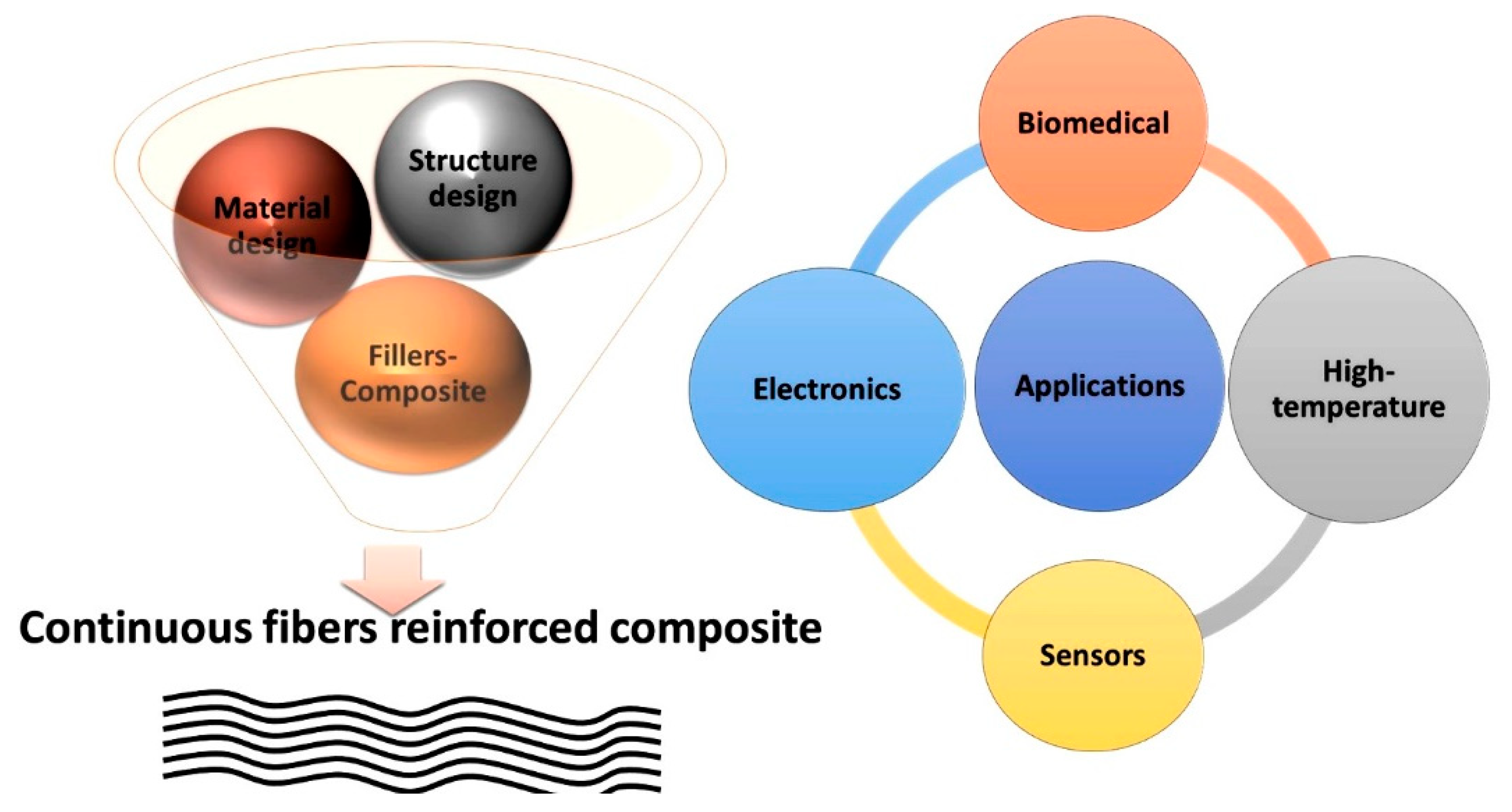
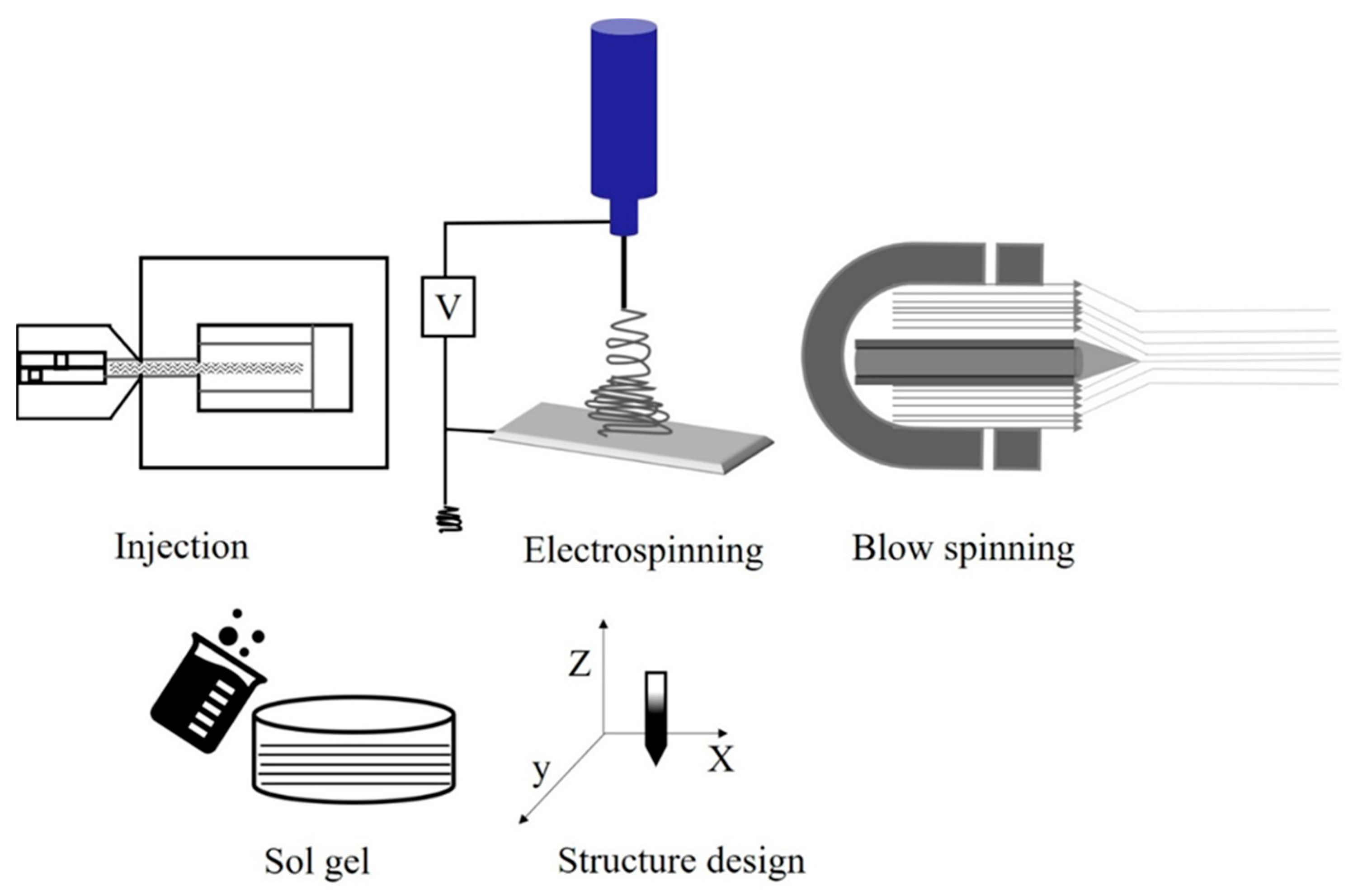
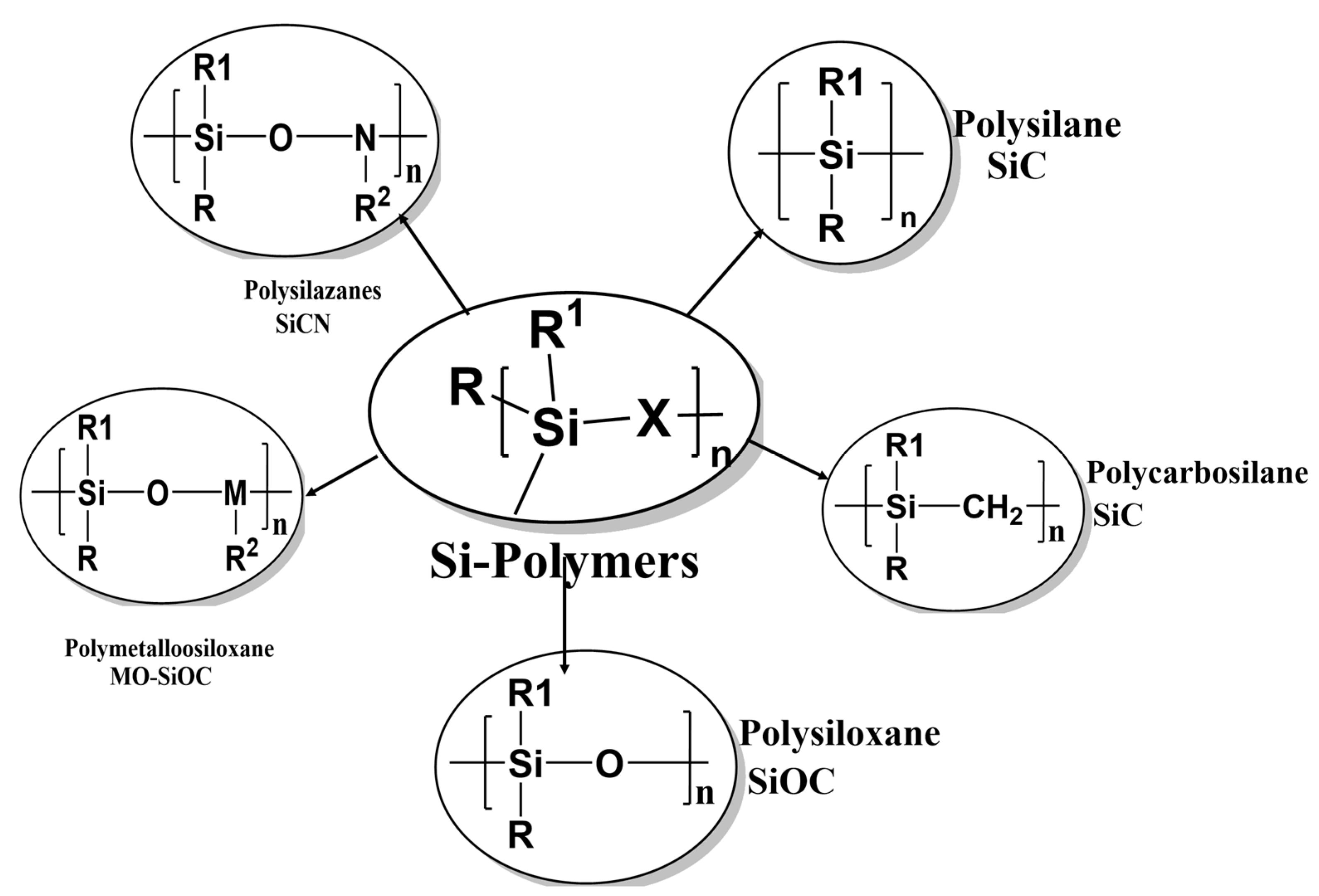

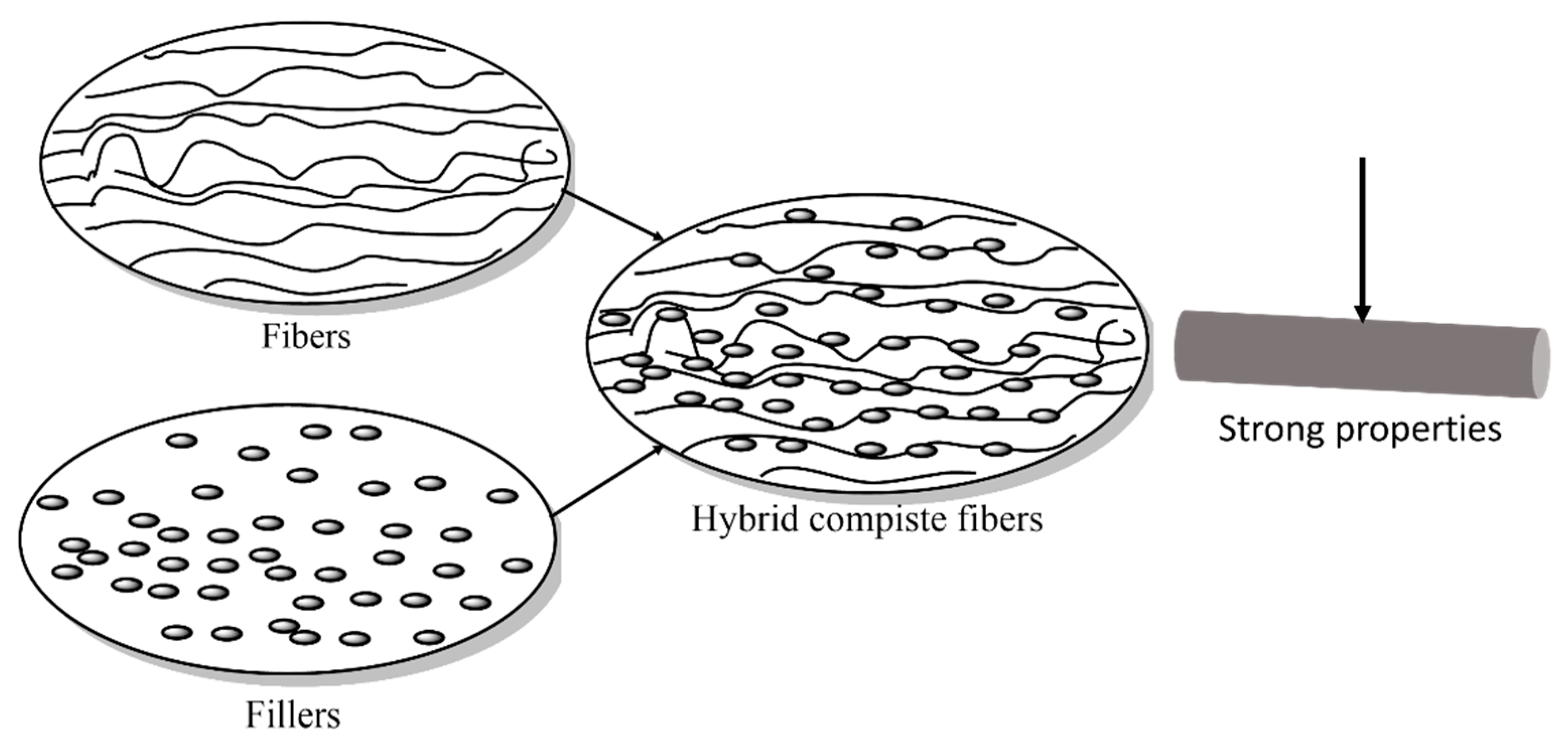
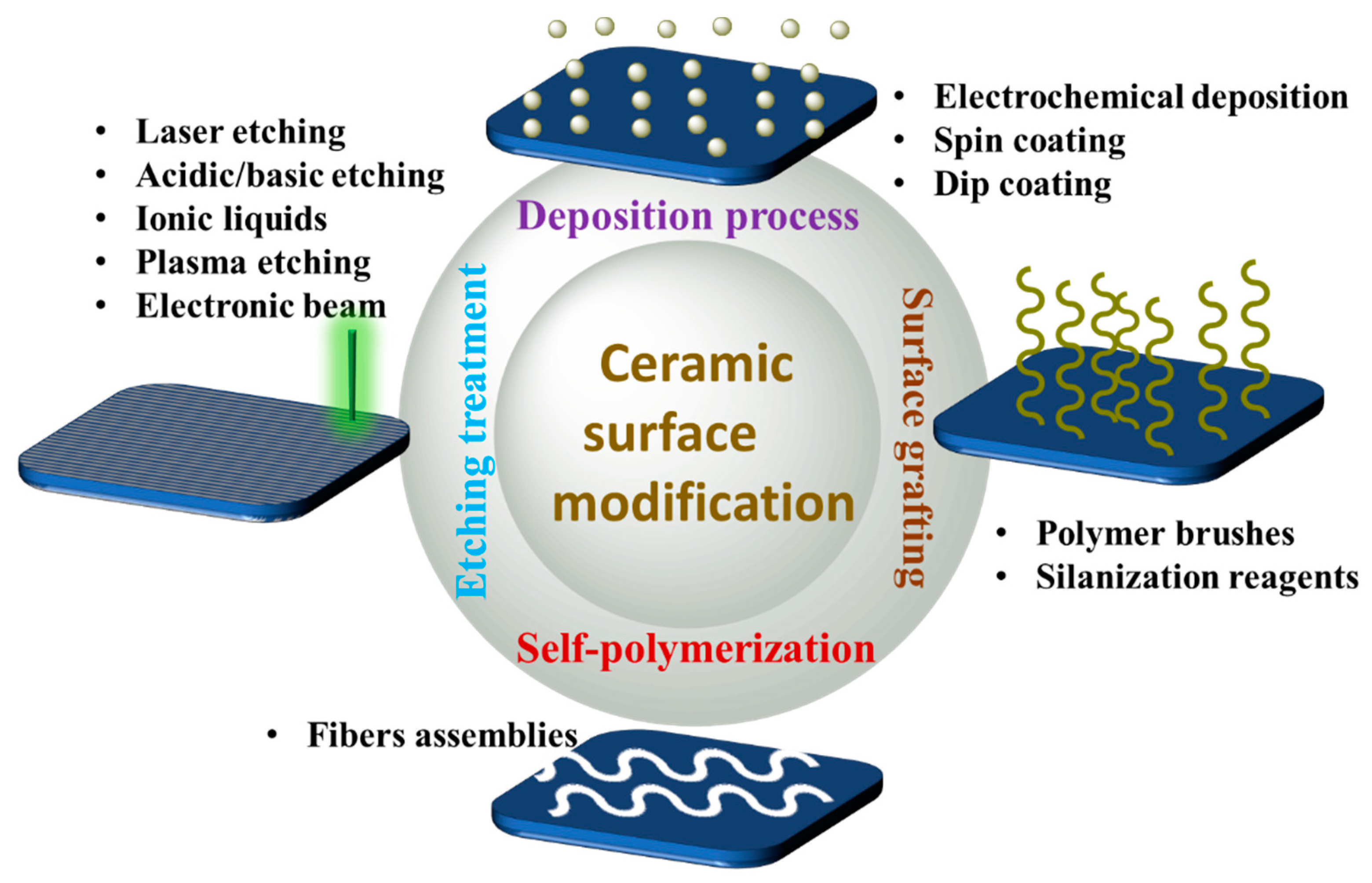
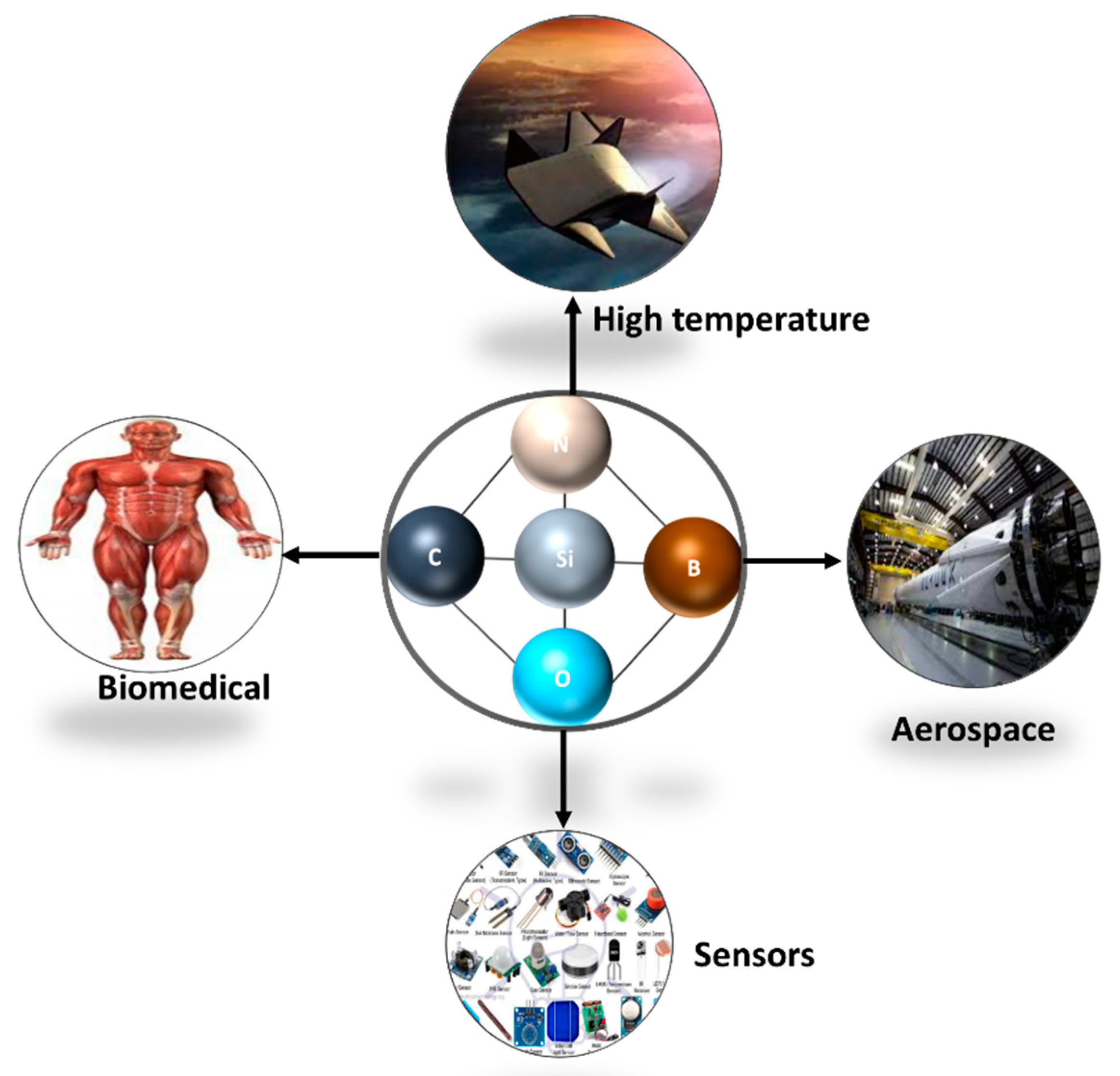
| Fabrication | Blow Spinning | Electrospinning |
|---|---|---|
| diameter | 80–1000 nm | 10–800 nm |
| mean pore size | 6–18 μm | 5 μm |
| porosity | ~97% | 70% |
Publisher’s Note: MDPI stays neutral with regard to jurisdictional claims in published maps and institutional affiliations. |
© 2022 by the authors. Licensee MDPI, Basel, Switzerland. This article is an open access article distributed under the terms and conditions of the Creative Commons Attribution (CC BY) license (https://creativecommons.org/licenses/by/4.0/).
Share and Cite
Kizhakke Veettil, S.; Kollarigowda, R.H.; Thakur, P. Approaches to Preceramic Polymer Fiber Fabrication and On-Demand Applications. Materials 2022, 15, 4546. https://doi.org/10.3390/ma15134546
Kizhakke Veettil S, Kollarigowda RH, Thakur P. Approaches to Preceramic Polymer Fiber Fabrication and On-Demand Applications. Materials. 2022; 15(13):4546. https://doi.org/10.3390/ma15134546
Chicago/Turabian StyleKizhakke Veettil, Soorya, Ravichandran H. Kollarigowda, and Pankaj Thakur. 2022. "Approaches to Preceramic Polymer Fiber Fabrication and On-Demand Applications" Materials 15, no. 13: 4546. https://doi.org/10.3390/ma15134546
APA StyleKizhakke Veettil, S., Kollarigowda, R. H., & Thakur, P. (2022). Approaches to Preceramic Polymer Fiber Fabrication and On-Demand Applications. Materials, 15(13), 4546. https://doi.org/10.3390/ma15134546







